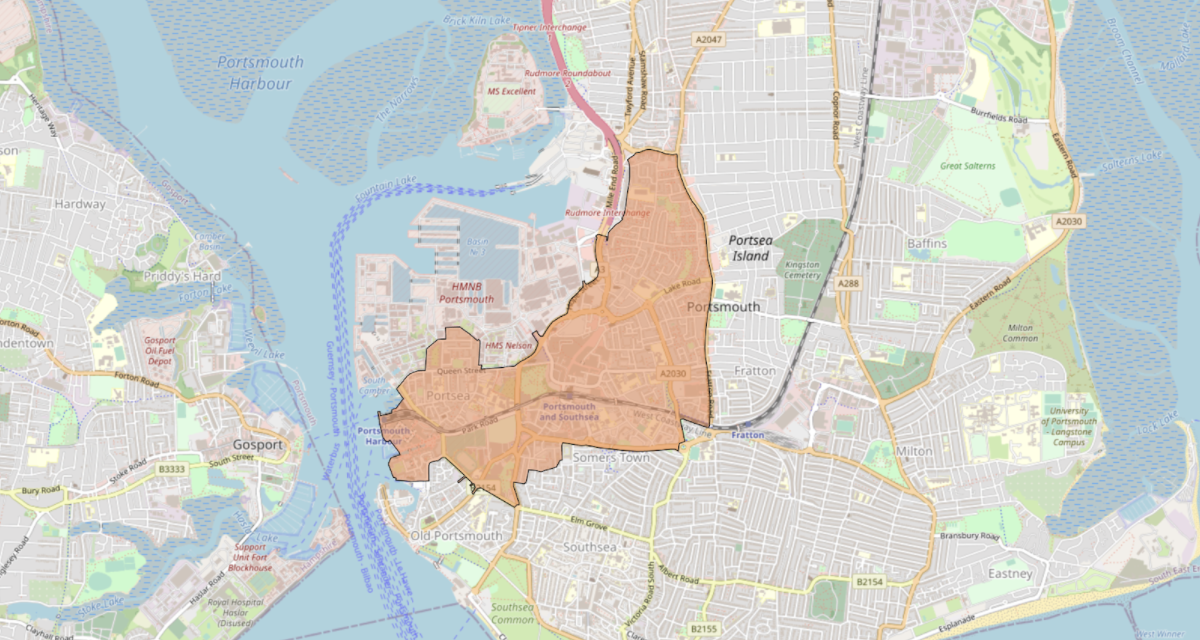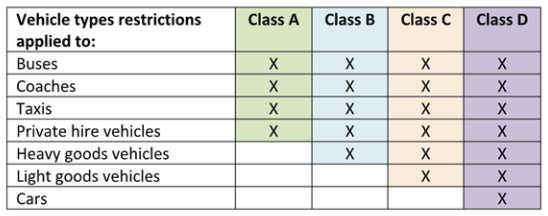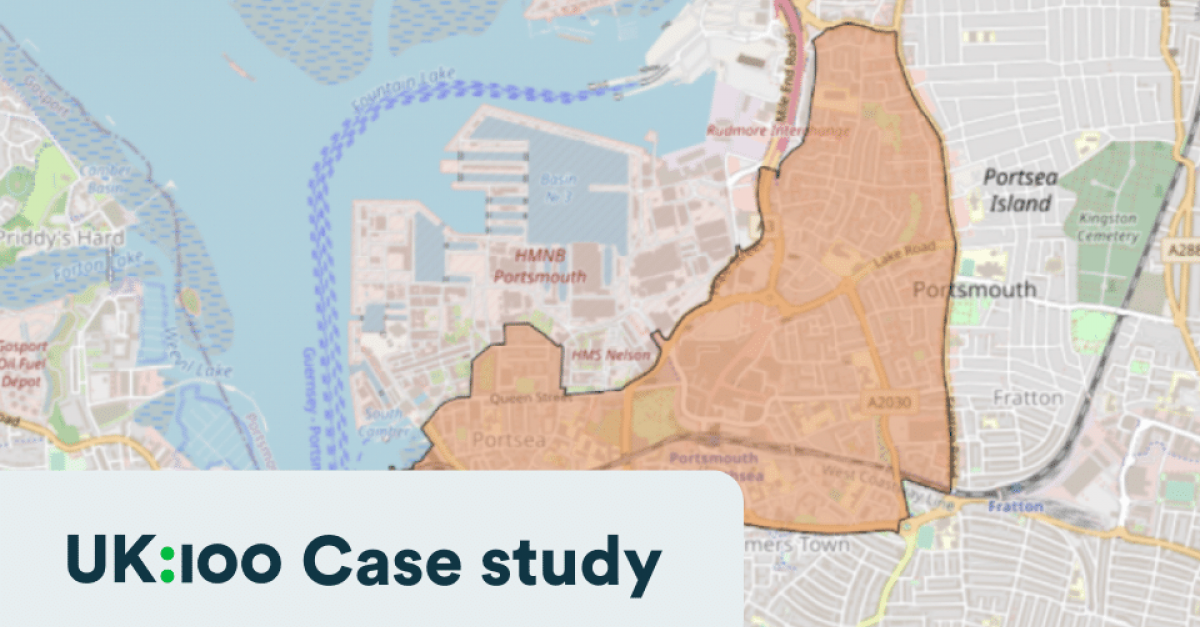In November 2021, Portsmouth City Council launched its Clean Air Zone (CAZ) with the objective of reducing illegal levels of Nitrogen Oxides (NOx), including Nitrogen Dioxide (NO2), to within legal limits in the shortest possible time. The City Council aims to tackle air quality for both public health and climate change reasons by:
- Helping to accelerate the uptake of low or zero emissions vehicles
- Financially supporting businesses most affected by the CAZ in upgrading their vehicles so that they are cleaner and compliant with the CAZ emission standards.
- Encouraging residents to use public transport and active travel methods
- Reducing congestion in the city centre

Figure 1 - The area covered by Portsmouth City Council’s CAZ
Poor air quality is the largest environmental risk to public health in the UK. Both short- and long-term exposure to poor air quality is linked to poor health at all stages of life, and has been shown to contribute to the development of asthma, cardiovascular and respiratory diseases, and lung cancer. It is estimated that the annual mortality burden of human-made air pollution in the UK is between 28,000 and 36,000 deaths. Traffic emissions are a major contributor of toxic pollutants such as carbon monoxide (CO), oxides of nitrogen (NOx) including Nitrogen Dioxide (NO2), volatile organic compounds (VOCs) and particulate matter (PM10).
Portsmouth city has illegal levels of air quality, as set out by the national Air Quality Standards Regulations, 2010. As such, Portsmouth City Council was mandated by central government to introduce a CAZ, as previously identified non-charging measures to reduce air pollution were shown to be insufficient on their own, or undeliverable within the required timescales to reduce air pollution quickly enough to meet the requirements of the ministerial directions. Such measures that were discounted included installing car sharing lanes, a vehicle scrappage scheme and relocation of the Isle of Wight ferry terminal to the Portsmouth International Port to reduce the need for ferry traffic to travel through the city. Drivers of high polluting vehicles (based on Euro emissions standards) will be charged for travelling through the zone.
Emissions modelling underpinned the location of the Portsmouth CAZ which covers an area of approximately 3 km2. The modelling demonstrated that there were likely to be two 'exceedance locations' where levels of NO2 would continue to be above legal limits in 2022 if a charging CAZ was not introduced as soon as possible. Therefore, the shape and location on the CAZ focuses on reducing levels of NO2 in these two exceedance locations.
CAZs operate at different classes, meaning there may be different charges and restrictions on different vehicles in the zone. The Portsmouth CAZ is a Class B Zone, meaning that heavy goods vehicles (HGVs), buses, coaches, taxis and private hire vehicles will all be charged to enter. The modelling shows that this is what is required to reduce emissions to within legal limits. HGVs, buses and coaches will be charged £50 per day of entry and taxis and private hire vehicles will be charged £10. The optimum level for the daily charges were identified by undertaking a stated preference survey. Through this survey drivers were asked how their behaviour might change in response to different levels of the charge to identify at what point drivers could be expected to choose to replace their vehicle for a lower polluting type, switch to a sustainable transport mode, or cancel their trip entirely instead of paying the daily charge. Private cars, vans and motorcycles will not be charged.

Figure 2 - The four classes of CAZs
Alongside the CAZ, Portsmouth City Council has successfully secured £2.7 million from the Government’s Clean Air Fund to help those most affected by the CAZ to upgrade their vehicles to be compliant with the CAZ. A team of 4 engagement officers have been working with businesses since March 2021 to award this funding.
Planning for the Portsmouth CAZ began in March 2018 with the first of four Ministerial Directions.
- Ministerial Direction 1 (March 2018): Required the Council to develop a Targeted Feasibility Study (TFS) by 31 July 2018 for two specified road links in the city: A3 Mile End Road and A3 Alfred Road. These two roads were selected as they were projected to have nitrogen dioxide (NO2) exceedances in Defra's national PCM model.
- Ministerial Direction 2 (October 2018): Following the results of the TFS, PCC were issued with a further Ministerial Direction in October 2018, this time to undertake a bus retrofit programme. The Ministerial Direction stipulated that the programme should be undertaken as quickly as possible with the purpose of bringing forward compliance with legal levels of NO2 on A3 Mile End Road and A3 Alfred Road.
- Ministerial Direction 3 (October 2018): The third Ministerial Direction required PCC to produce an Air Quality Local Plan to set out the case for delivering compliance with legal limits for NO2 in the shortest possible time. The Outline Business Case for this Plan was submitted in October 2019.
- Ministerial Direction (March 2020): The fourth Ministerial Direction required PCC to implement a Class B charging Clean Air Zone, and supporting measures, in Portsmouth as soon as possible and in time to bring forward compliance with legal limits for nitrogen dioxide to 2022.
The final Ministerial Direction, in March 2020, required Portsmouth to implement a Class B charging CAZ alongside additional supporting measures, such as changes to traffic signals and taxi licensing policy.
Consultations were undertaken in June 2019 and Summer 2020, the results of which were used to inform the final design of the CAZ which went live on the 29th November 2021. The scheme will be in place for as long as is needed to reduce emissions to within legal limits at the two exceedance locations, whilst ensuring that new exceedances are not created elsewhere in the city.
The CAZ in Portsmouth was delivered in a collaboration with national government, including DfT and DEFRA’s Joint Air Quality Unit (JAQU), and the Driver and Vehicle Licensing Agency (DVLA). Internally, the project required co-ordinated work and collaboration across many departments at the City Council including: Licensing, IT, Finance, Energy, Waste, Parking, Enforcement and the customer facing City Help Desk teams, to introduce long lasting business change. Externally, Bath & North East Somerset Council and Birmingham City Council were both consulted to share their expertise and learn from their experiences with CAZs.
Technical consultants from Atkins, Aecom and Systra were also employed to undertake technical transport modelling and air quality modelling, as well as to support the development of business cases. Their support facilitated the approval of the Council’s submission to JAQU.
Local businesses and residents, located in the city and further afield, were engaged extensively during two consultation periods to build public consent and buy-in for the new scheme. The results of their consultation informed the final design of the CAZ. Alongside this, the Council has had a team of dedicated engagement officers who have worked throughout the past year to help businesses and residents most affected to prepare for the CAZ and replace their vehicles.

Figure 3 - Key stakeholders engagement carried out by Council engaged ahead of implementation of the CAZ
The £2.3million required for the infrastructure of the Portsmouth CAZ has been funded by central government, which enabled the Council to meet its obligations in reducing emissions to within legal limits in the shortest possible time.
The revenue generated from the CAZ will cover the operational costs of the Zone. There is not expected to be a significant surplus revenue from the operation of the CAZ. The more successful the CAZ is in encouraging change, the less revenue will be generated. In the unlikely event that the CAZ generates any surplus revenue this will be invested into delivering the measures identified in the city council's new transport strategy, Local Transport Plan 4.
Portsmouth City Council were also successful in obtaining £2.7 million funding from the Government's Clean Air Fund which was used to facilitate the upgrade of the many of the vehicles operating in the city, including staff costs and the installation of infrastructure to support this (such as EV rapid chargers for the taxi trade). The following sums were allocated per vehicle:
- £900,000 for buses and coaches issued as £15,000 per vehicle
- £1,120,000 for HGVs issued as £16,000 per vehicle
- £684,500 for taxis and PHVs issued as £5,000 per wheelchair accessible vehicle
- £1,500 per standard vehicle
Transport contributes to 22% of Portsmouth’s carbon emissions, and therefore was identified as a key priority area in the 'Portsmouth Climate Change Strategy’ (2020). The CAZ will not only reduce illegal levels of air pollution, but facilitate the Council’s transport strategy to encourage modal shift to non-car based transport, reducing congestion and poor air quality. Areawide emissions reductions are expected, which will also contribute towards the health agenda and making the streets of Portsmouth more attractive places for residents and visitors to walk and cycle in.
- The modelling for the Portsmouth CAZ has shown that it will reduce levels of NOx to within legal limits (40 µg/m3), as per the Air Quality Standards Regulations 2010.
- The CAZ is also likely to have broader impacts on air quality, with businesses upgrading vehicles to operate in the Zone also operating elsewhere in the city. This is particularly the case with taxis, as changes to licensing policy in parallel with the CAZ will mean that only newer, less polluting vehicles can be licensed with the council, with older vehicles being phased out over the next few years.
- Portsmouth will continue to invest in schemes to improve Air Quality within the Council, embedding it into policies across the Council.
- CAZs were once unpopular and widely opposed. Portsmouth is only the third city to introduce a CAZ. With active sharing of knowledge and expertise other local authorities will be more encouraged to plan similar interventions, mandated or not.
- Cllr Gerald Vernon-Jackson, Leader of Portsmouth City Council said: "It is really important to improve air quality in Portsmouth. The modelling from the government was that if the CAZ was imposed, the air quality would meet the legal limit in 2022 instead of 2023 if no action was taken. The government advice says that when air quality is at legal limits then the CAZ will be removed and this should happen next year at the latest."
- The council also asked for additional measures to be put in place alongside the CAZ. Cllr Gerald Vernon-Jackson said: "We asked for a scrappage scheme for the oldest and most polluting vehicles located within the Clean Air Zone. The government rejected this. There was also a call for reduced costs of bus travel to encourage people to leave their cars at home and go by bus. Again the government rejected this.” He said the CAZ “has been expensive to implement when cheaper and better ways to address air quality were available."
- The collaboration required to deliver the project, both internal and external, worked well with Portsmouth achieving all the agreed milestones in the run up to CAZ launch.
- The coupling of the CAZ with the Clean Air Fund meant that vehicle owners were able to upgrade their vehicles ahead of CAZ launch. This increased the likelihood of the scheme working long term, as those newer or retrofitted vehicles will continue to operate beyond the life of the CAZ, instead of the more polluting vehicles they replaced.
- To ensure that the expected drop in emissions will be maintained, the CAZ will be in place until the Government's Joint Air Quality Unit is satisfied that any changes are permanent.
- Extensive work was done particularly with those parts of the Council who have inherited the CAZ in its operation phase - the Helpdesk teams assisting the public and the Parking team who will manage exemptions and enforce against non-payment, so that they were fully trained in how the CAZ operated and were able to seamlessly take over when the CAZ launched.


